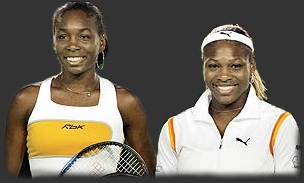23 January 2003, By Christopher Clarey, NY Times
MELBOURNE, Australia — When Serena Williams's compelling comeback against Kim Clijsters in the Australian Open semifinals ended in bright sunlight, with Venus Williams watching from the stands, the history-making sisters had added another achievement to their collective résumé. No other players in the 35-year history of Open tennis have played each other in four consecutive Grand Slam finals: not Martina Navratilova and Chris Evert; not Steffi Graf and Monica Seles.
Venus and Serena Williams will complete that cycle on Saturday in what will be the first Australian Open final for each. The bigger issue is whether Venus Williams can keep her sister from completing a cycle of her own, the eponymous Serena Slam. Serena Williams defeated her older sister in the last three Grand Slam tournaments last year. She has won 27 singles matches in a row in the majors, and though a victory on Saturday would not give her a true Grand Slam, a term used for winning all four in the same calendar year, it would be a powerful statement in light of the increasing depth, talent and prize money in the modern women's game.
"Hopefully this time it will be different than the last three," Venus Williams said after her 6-3, 6-3 victory over Justine Henin-Hardenne, Clijsters's less robust Belgian compatriot, in today's first semifinal.
With one Williams sister already in the final at this Grand Slam event, modern tennis etiquette dictated that the other Williams sister needed to be next. While Clijsters came agonizingly close to changing the unwritten rule, it was ultimately Serena Williams who fought off two match points and a 1-5 deficit in the third set to keep her now-customary date with her sister.
"It was just an unbelievable battle out there," Serena Williams said of her 4-6, 6-3, 7-5 victory. "I thought, `I don't want to lose 6-1.' Then I said, `I don't want to lose 6-2.' So I just kept fighting. Next thing, I know I came back."
Venus Williams's performance was far from flawless as she beat Henin-Hardenne for the seventh successive time. There were too many unforced errors, double faults and missed opportunities on serve for that. But it was still convincing, as Venus Williams maintained the positive, attacking frame of mind she brought into the new year: pouncing on short balls with obvious relish, pushing forward with regularity and playing just enough great defense to keep her talented, athletic opponent from turning a competitive match into a suspenseful match.
How difficult will it be on Saturday for Venus Williams to know that the best tennis player in her family is trying to win four Grand Slam titles in a row? "On the court I'm a competitor," Venus Williams said. "No matter who it is, I hate to lose. The same with her — maybe her, even more. Of course we're sisters. If she were to twist her ankle on the court, of course I'd be concerned, but I would still have to go out and hit the next shot. That's the way it is."
It was clear, right from the first exchange, that Serena Williams was going to have to hit plenty of fine shots to shake free of the fourth-seeded Clijsters. As the match wore on, it was also clear that Williams, who was three points from defeat in the first round against Emilie Loit, was far from her best again. She would finish with 65 unforced errors to Clijsters's 33. But though the top-seeded American struggled mightily with her consistency and sought treatment for three blisters on her right foot while trailing by 1-2 in the final set, she eventually reminded Clijsters and anybody else watching why she is one of the world's most remarkable athletes.
The crowd in Rod Laver Arena did not like Williams's decision to take an injury timeout, considering it an attempt to break Clijster's rhythm. But they would have reacted differently if they had seen the up-close television footage of the burst blister on the ball of her foot. http://www.nytimes.com/2003/01/23/sports/tennis/23CND_TENN.html
Previous Page | Continue...
NOTE: In accordance with Title 17 U.S.C. section 107, this material is distributed without profit or payment to those who have expressed a prior interest in receiving this information for non-profit research and educational purposes only. For more information go to: http://www.law.cornell.edu/uscode/17/107.shtml. If you wish to use copyrighted material from this site for purposes of your own that go beyond 'fair use', you must obtain permission from the copyright owner.
